An Analysis of Global Poverty's Impact on Vulnerable Populations
VerifiedAdded on 2020/05/04
|7
|2046
|62
Essay
AI Summary
This essay delves into the pervasive issue of global poverty, focusing on its particularly devastating effects on vulnerable populations such as women, children, refugees, and the elderly. It explores the multifaceted nature of absolute poverty, examining how societal structures, economic disparities, and various forms of discrimination contribute to the increased vulnerability of these groups. The essay highlights the challenges faced by children in developing nations, the feminization of poverty, the struggles of refugees displaced by conflict or disaster, and the plight of the elderly in a world grappling with an aging population. Drawing on various sociological perspectives and research, the essay aims to shed light on the complex factors that perpetuate poverty and its devastating consequences, emphasizing the need for comprehensive strategies to address these challenges and promote social justice.
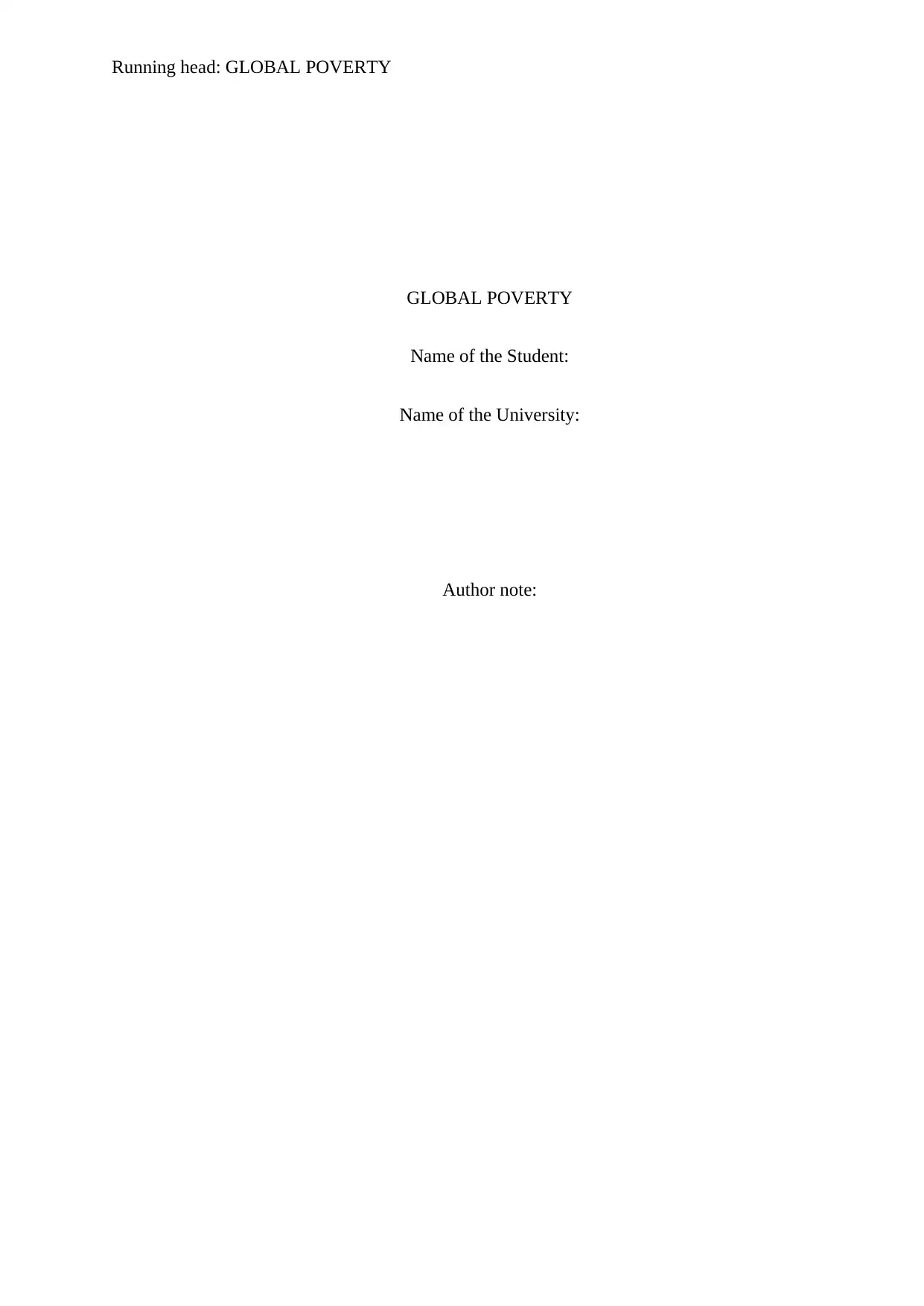
Running head: GLOBAL POVERTY
GLOBAL POVERTY
Name of the Student:
Name of the University:
Author note:
GLOBAL POVERTY
Name of the Student:
Name of the University:
Author note:
Paraphrase This Document
Need a fresh take? Get an instant paraphrase of this document with our AI Paraphraser
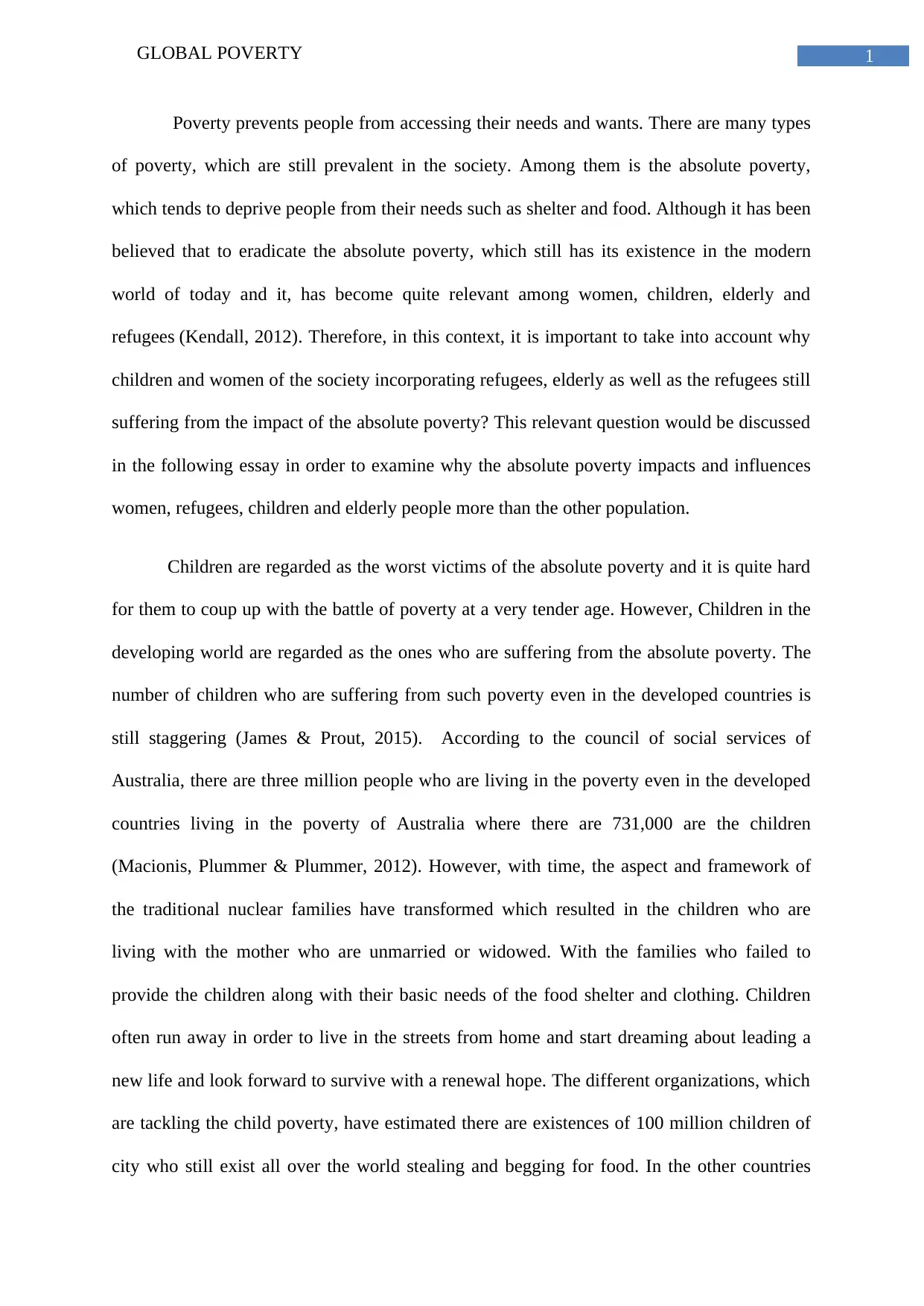
1GLOBAL POVERTY
Poverty prevents people from accessing their needs and wants. There are many types
of poverty, which are still prevalent in the society. Among them is the absolute poverty,
which tends to deprive people from their needs such as shelter and food. Although it has been
believed that to eradicate the absolute poverty, which still has its existence in the modern
world of today and it, has become quite relevant among women, children, elderly and
refugees (Kendall, 2012). Therefore, in this context, it is important to take into account why
children and women of the society incorporating refugees, elderly as well as the refugees still
suffering from the impact of the absolute poverty? This relevant question would be discussed
in the following essay in order to examine why the absolute poverty impacts and influences
women, refugees, children and elderly people more than the other population.
Children are regarded as the worst victims of the absolute poverty and it is quite hard
for them to coup up with the battle of poverty at a very tender age. However, Children in the
developing world are regarded as the ones who are suffering from the absolute poverty. The
number of children who are suffering from such poverty even in the developed countries is
still staggering (James & Prout, 2015). According to the council of social services of
Australia, there are three million people who are living in the poverty even in the developed
countries living in the poverty of Australia where there are 731,000 are the children
(Macionis, Plummer & Plummer, 2012). However, with time, the aspect and framework of
the traditional nuclear families have transformed which resulted in the children who are
living with the mother who are unmarried or widowed. With the families who failed to
provide the children along with their basic needs of the food shelter and clothing. Children
often run away in order to live in the streets from home and start dreaming about leading a
new life and look forward to survive with a renewal hope. The different organizations, which
are tackling the child poverty, have estimated there are existences of 100 million children of
city who still exist all over the world stealing and begging for food. In the other countries
Poverty prevents people from accessing their needs and wants. There are many types
of poverty, which are still prevalent in the society. Among them is the absolute poverty,
which tends to deprive people from their needs such as shelter and food. Although it has been
believed that to eradicate the absolute poverty, which still has its existence in the modern
world of today and it, has become quite relevant among women, children, elderly and
refugees (Kendall, 2012). Therefore, in this context, it is important to take into account why
children and women of the society incorporating refugees, elderly as well as the refugees still
suffering from the impact of the absolute poverty? This relevant question would be discussed
in the following essay in order to examine why the absolute poverty impacts and influences
women, refugees, children and elderly people more than the other population.
Children are regarded as the worst victims of the absolute poverty and it is quite hard
for them to coup up with the battle of poverty at a very tender age. However, Children in the
developing world are regarded as the ones who are suffering from the absolute poverty. The
number of children who are suffering from such poverty even in the developed countries is
still staggering (James & Prout, 2015). According to the council of social services of
Australia, there are three million people who are living in the poverty even in the developed
countries living in the poverty of Australia where there are 731,000 are the children
(Macionis, Plummer & Plummer, 2012). However, with time, the aspect and framework of
the traditional nuclear families have transformed which resulted in the children who are
living with the mother who are unmarried or widowed. With the families who failed to
provide the children along with their basic needs of the food shelter and clothing. Children
often run away in order to live in the streets from home and start dreaming about leading a
new life and look forward to survive with a renewal hope. The different organizations, which
are tackling the child poverty, have estimated there are existences of 100 million children of
city who still exist all over the world stealing and begging for food. In the other countries
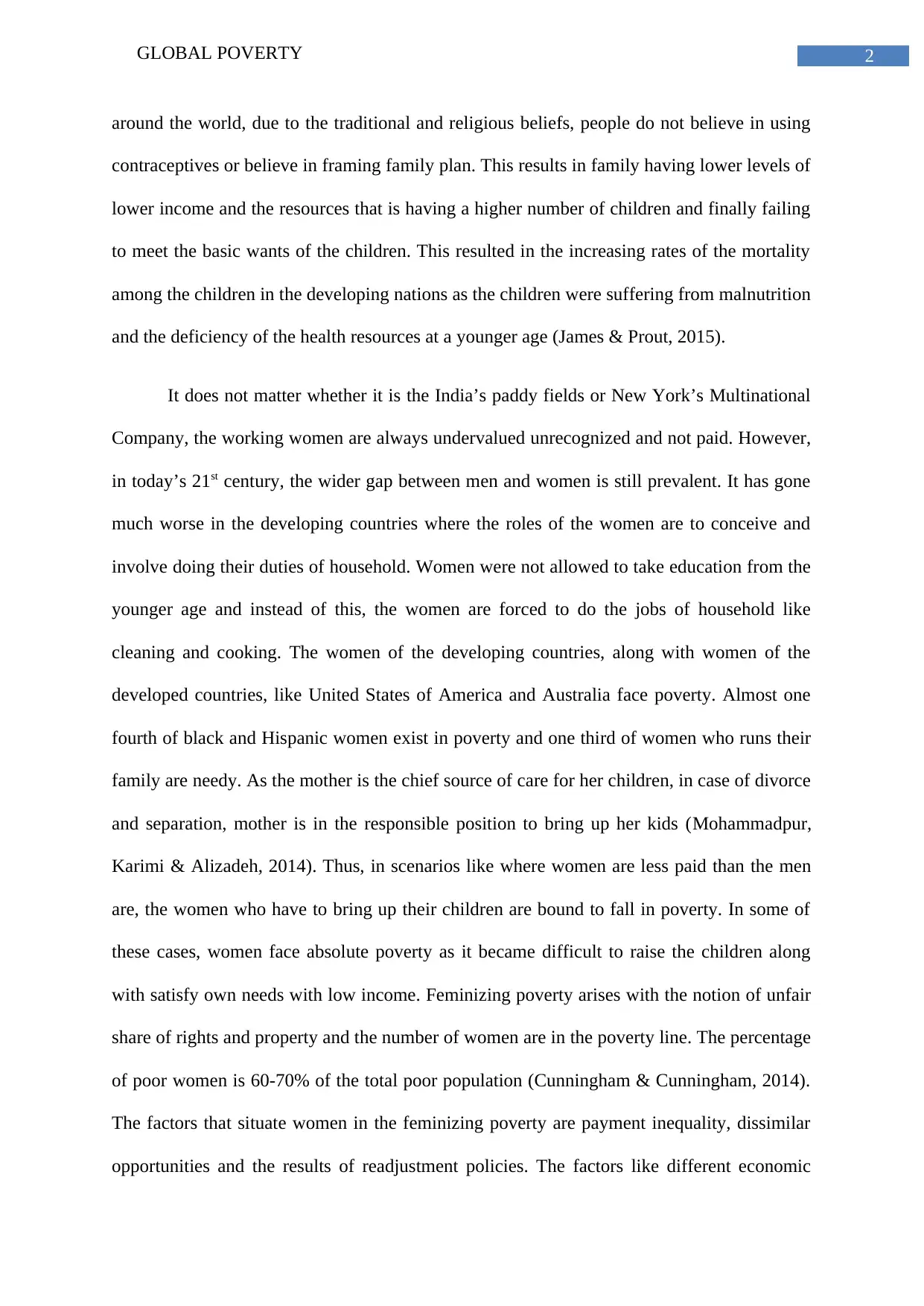
2GLOBAL POVERTY
around the world, due to the traditional and religious beliefs, people do not believe in using
contraceptives or believe in framing family plan. This results in family having lower levels of
lower income and the resources that is having a higher number of children and finally failing
to meet the basic wants of the children. This resulted in the increasing rates of the mortality
among the children in the developing nations as the children were suffering from malnutrition
and the deficiency of the health resources at a younger age (James & Prout, 2015).
It does not matter whether it is the India’s paddy fields or New York’s Multinational
Company, the working women are always undervalued unrecognized and not paid. However,
in today’s 21st century, the wider gap between men and women is still prevalent. It has gone
much worse in the developing countries where the roles of the women are to conceive and
involve doing their duties of household. Women were not allowed to take education from the
younger age and instead of this, the women are forced to do the jobs of household like
cleaning and cooking. The women of the developing countries, along with women of the
developed countries, like United States of America and Australia face poverty. Almost one
fourth of black and Hispanic women exist in poverty and one third of women who runs their
family are needy. As the mother is the chief source of care for her children, in case of divorce
and separation, mother is in the responsible position to bring up her kids (Mohammadpur,
Karimi & Alizadeh, 2014). Thus, in scenarios like where women are less paid than the men
are, the women who have to bring up their children are bound to fall in poverty. In some of
these cases, women face absolute poverty as it became difficult to raise the children along
with satisfy own needs with low income. Feminizing poverty arises with the notion of unfair
share of rights and property and the number of women are in the poverty line. The percentage
of poor women is 60-70% of the total poor population (Cunningham & Cunningham, 2014).
The factors that situate women in the feminizing poverty are payment inequality, dissimilar
opportunities and the results of readjustment policies. The factors like different economic
around the world, due to the traditional and religious beliefs, people do not believe in using
contraceptives or believe in framing family plan. This results in family having lower levels of
lower income and the resources that is having a higher number of children and finally failing
to meet the basic wants of the children. This resulted in the increasing rates of the mortality
among the children in the developing nations as the children were suffering from malnutrition
and the deficiency of the health resources at a younger age (James & Prout, 2015).
It does not matter whether it is the India’s paddy fields or New York’s Multinational
Company, the working women are always undervalued unrecognized and not paid. However,
in today’s 21st century, the wider gap between men and women is still prevalent. It has gone
much worse in the developing countries where the roles of the women are to conceive and
involve doing their duties of household. Women were not allowed to take education from the
younger age and instead of this, the women are forced to do the jobs of household like
cleaning and cooking. The women of the developing countries, along with women of the
developed countries, like United States of America and Australia face poverty. Almost one
fourth of black and Hispanic women exist in poverty and one third of women who runs their
family are needy. As the mother is the chief source of care for her children, in case of divorce
and separation, mother is in the responsible position to bring up her kids (Mohammadpur,
Karimi & Alizadeh, 2014). Thus, in scenarios like where women are less paid than the men
are, the women who have to bring up their children are bound to fall in poverty. In some of
these cases, women face absolute poverty as it became difficult to raise the children along
with satisfy own needs with low income. Feminizing poverty arises with the notion of unfair
share of rights and property and the number of women are in the poverty line. The percentage
of poor women is 60-70% of the total poor population (Cunningham & Cunningham, 2014).
The factors that situate women in the feminizing poverty are payment inequality, dissimilar
opportunities and the results of readjustment policies. The factors like different economic
⊘ This is a preview!⊘
Do you want full access?
Subscribe today to unlock all pages.

Trusted by 1+ million students worldwide
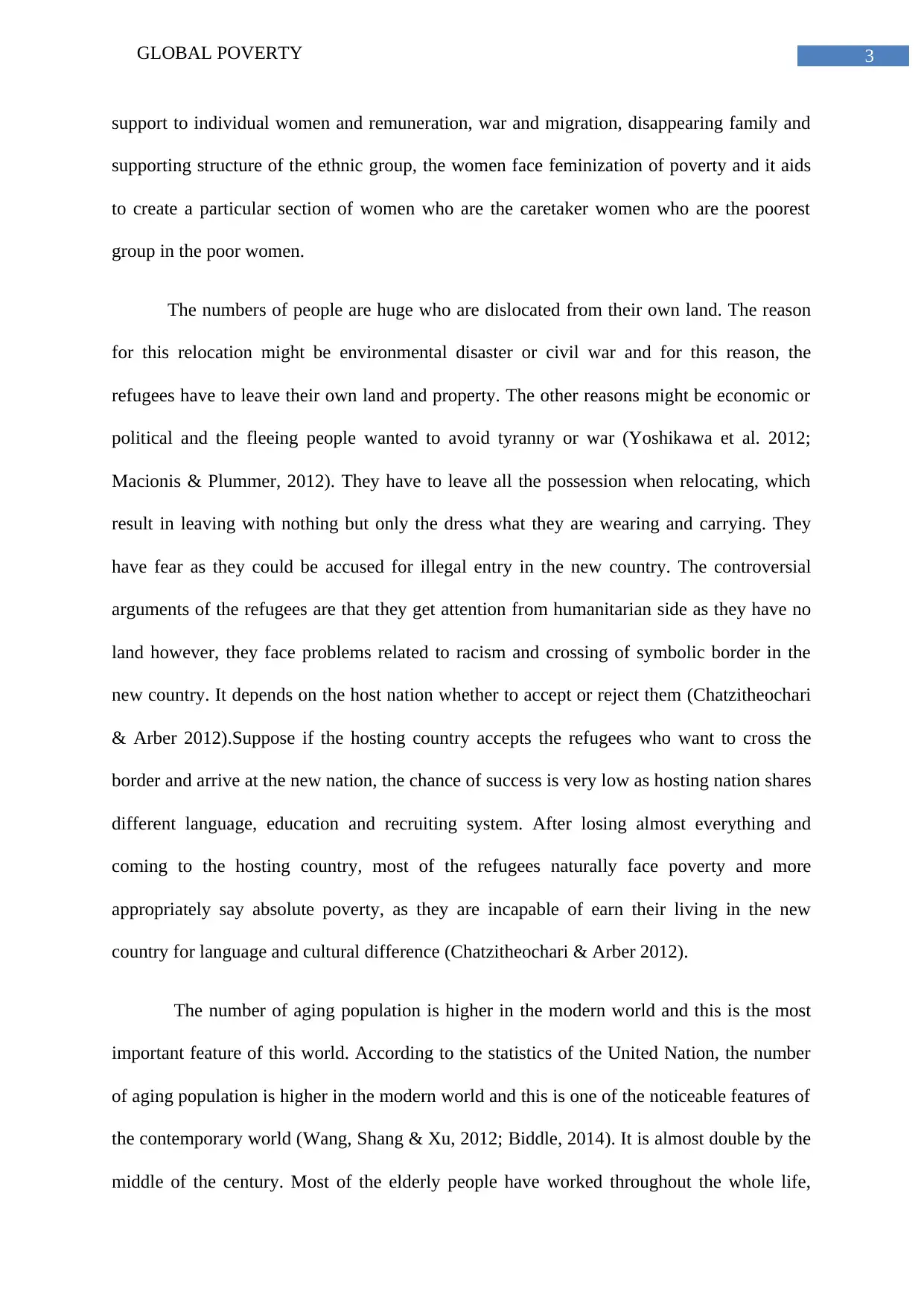
3GLOBAL POVERTY
support to individual women and remuneration, war and migration, disappearing family and
supporting structure of the ethnic group, the women face feminization of poverty and it aids
to create a particular section of women who are the caretaker women who are the poorest
group in the poor women.
The numbers of people are huge who are dislocated from their own land. The reason
for this relocation might be environmental disaster or civil war and for this reason, the
refugees have to leave their own land and property. The other reasons might be economic or
political and the fleeing people wanted to avoid tyranny or war (Yoshikawa et al. 2012;
Macionis & Plummer, 2012). They have to leave all the possession when relocating, which
result in leaving with nothing but only the dress what they are wearing and carrying. They
have fear as they could be accused for illegal entry in the new country. The controversial
arguments of the refugees are that they get attention from humanitarian side as they have no
land however, they face problems related to racism and crossing of symbolic border in the
new country. It depends on the host nation whether to accept or reject them (Chatzitheochari
& Arber 2012).Suppose if the hosting country accepts the refugees who want to cross the
border and arrive at the new nation, the chance of success is very low as hosting nation shares
different language, education and recruiting system. After losing almost everything and
coming to the hosting country, most of the refugees naturally face poverty and more
appropriately say absolute poverty, as they are incapable of earn their living in the new
country for language and cultural difference (Chatzitheochari & Arber 2012).
The number of aging population is higher in the modern world and this is the most
important feature of this world. According to the statistics of the United Nation, the number
of aging population is higher in the modern world and this is one of the noticeable features of
the contemporary world (Wang, Shang & Xu, 2012; Biddle, 2014). It is almost double by the
middle of the century. Most of the elderly people have worked throughout the whole life,
support to individual women and remuneration, war and migration, disappearing family and
supporting structure of the ethnic group, the women face feminization of poverty and it aids
to create a particular section of women who are the caretaker women who are the poorest
group in the poor women.
The numbers of people are huge who are dislocated from their own land. The reason
for this relocation might be environmental disaster or civil war and for this reason, the
refugees have to leave their own land and property. The other reasons might be economic or
political and the fleeing people wanted to avoid tyranny or war (Yoshikawa et al. 2012;
Macionis & Plummer, 2012). They have to leave all the possession when relocating, which
result in leaving with nothing but only the dress what they are wearing and carrying. They
have fear as they could be accused for illegal entry in the new country. The controversial
arguments of the refugees are that they get attention from humanitarian side as they have no
land however, they face problems related to racism and crossing of symbolic border in the
new country. It depends on the host nation whether to accept or reject them (Chatzitheochari
& Arber 2012).Suppose if the hosting country accepts the refugees who want to cross the
border and arrive at the new nation, the chance of success is very low as hosting nation shares
different language, education and recruiting system. After losing almost everything and
coming to the hosting country, most of the refugees naturally face poverty and more
appropriately say absolute poverty, as they are incapable of earn their living in the new
country for language and cultural difference (Chatzitheochari & Arber 2012).
The number of aging population is higher in the modern world and this is the most
important feature of this world. According to the statistics of the United Nation, the number
of aging population is higher in the modern world and this is one of the noticeable features of
the contemporary world (Wang, Shang & Xu, 2012; Biddle, 2014). It is almost double by the
middle of the century. Most of the elderly people have worked throughout the whole life,
Paraphrase This Document
Need a fresh take? Get an instant paraphrase of this document with our AI Paraphraser
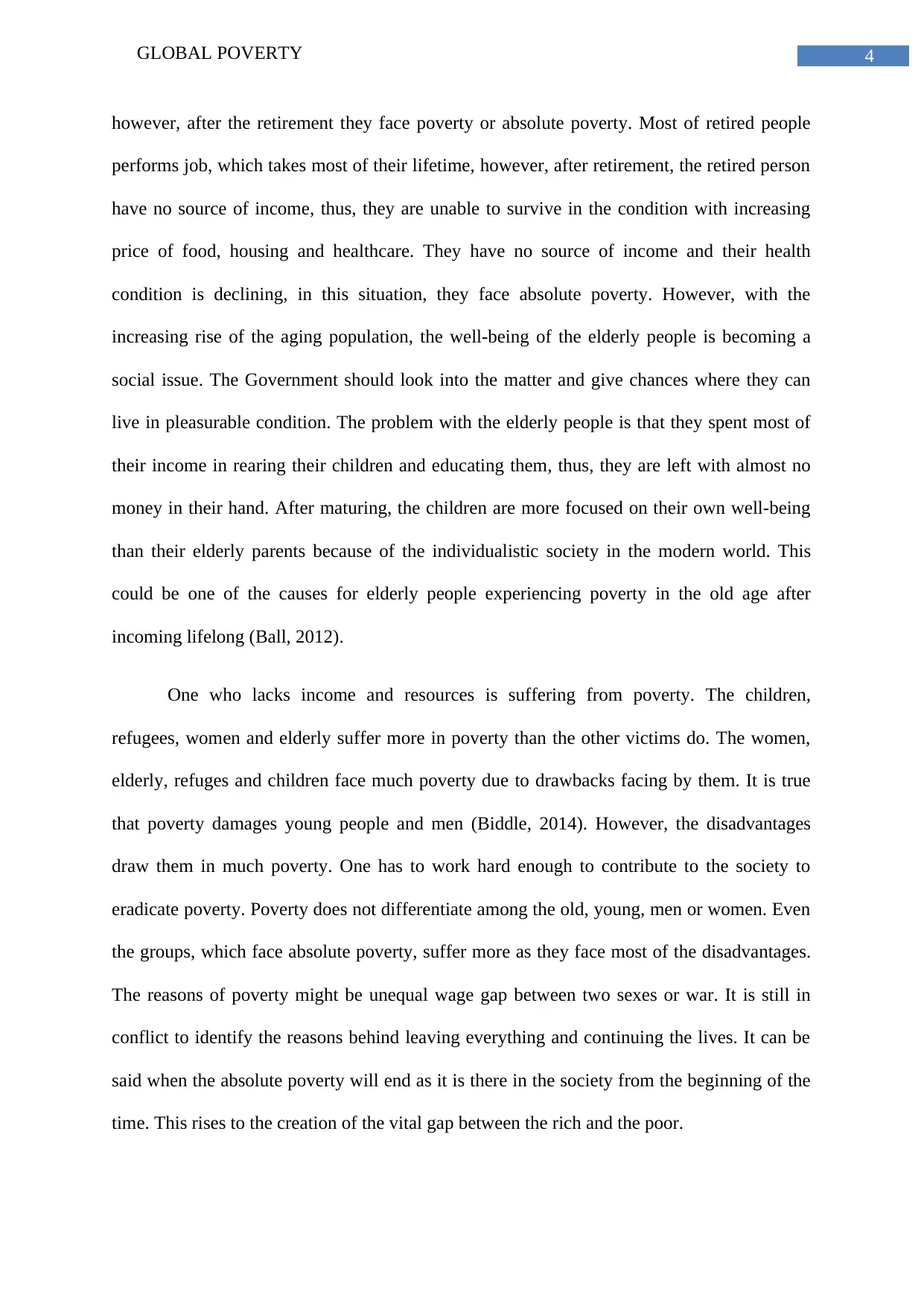
4GLOBAL POVERTY
however, after the retirement they face poverty or absolute poverty. Most of retired people
performs job, which takes most of their lifetime, however, after retirement, the retired person
have no source of income, thus, they are unable to survive in the condition with increasing
price of food, housing and healthcare. They have no source of income and their health
condition is declining, in this situation, they face absolute poverty. However, with the
increasing rise of the aging population, the well-being of the elderly people is becoming a
social issue. The Government should look into the matter and give chances where they can
live in pleasurable condition. The problem with the elderly people is that they spent most of
their income in rearing their children and educating them, thus, they are left with almost no
money in their hand. After maturing, the children are more focused on their own well-being
than their elderly parents because of the individualistic society in the modern world. This
could be one of the causes for elderly people experiencing poverty in the old age after
incoming lifelong (Ball, 2012).
One who lacks income and resources is suffering from poverty. The children,
refugees, women and elderly suffer more in poverty than the other victims do. The women,
elderly, refuges and children face much poverty due to drawbacks facing by them. It is true
that poverty damages young people and men (Biddle, 2014). However, the disadvantages
draw them in much poverty. One has to work hard enough to contribute to the society to
eradicate poverty. Poverty does not differentiate among the old, young, men or women. Even
the groups, which face absolute poverty, suffer more as they face most of the disadvantages.
The reasons of poverty might be unequal wage gap between two sexes or war. It is still in
conflict to identify the reasons behind leaving everything and continuing the lives. It can be
said when the absolute poverty will end as it is there in the society from the beginning of the
time. This rises to the creation of the vital gap between the rich and the poor.
however, after the retirement they face poverty or absolute poverty. Most of retired people
performs job, which takes most of their lifetime, however, after retirement, the retired person
have no source of income, thus, they are unable to survive in the condition with increasing
price of food, housing and healthcare. They have no source of income and their health
condition is declining, in this situation, they face absolute poverty. However, with the
increasing rise of the aging population, the well-being of the elderly people is becoming a
social issue. The Government should look into the matter and give chances where they can
live in pleasurable condition. The problem with the elderly people is that they spent most of
their income in rearing their children and educating them, thus, they are left with almost no
money in their hand. After maturing, the children are more focused on their own well-being
than their elderly parents because of the individualistic society in the modern world. This
could be one of the causes for elderly people experiencing poverty in the old age after
incoming lifelong (Ball, 2012).
One who lacks income and resources is suffering from poverty. The children,
refugees, women and elderly suffer more in poverty than the other victims do. The women,
elderly, refuges and children face much poverty due to drawbacks facing by them. It is true
that poverty damages young people and men (Biddle, 2014). However, the disadvantages
draw them in much poverty. One has to work hard enough to contribute to the society to
eradicate poverty. Poverty does not differentiate among the old, young, men or women. Even
the groups, which face absolute poverty, suffer more as they face most of the disadvantages.
The reasons of poverty might be unequal wage gap between two sexes or war. It is still in
conflict to identify the reasons behind leaving everything and continuing the lives. It can be
said when the absolute poverty will end as it is there in the society from the beginning of the
time. This rises to the creation of the vital gap between the rich and the poor.
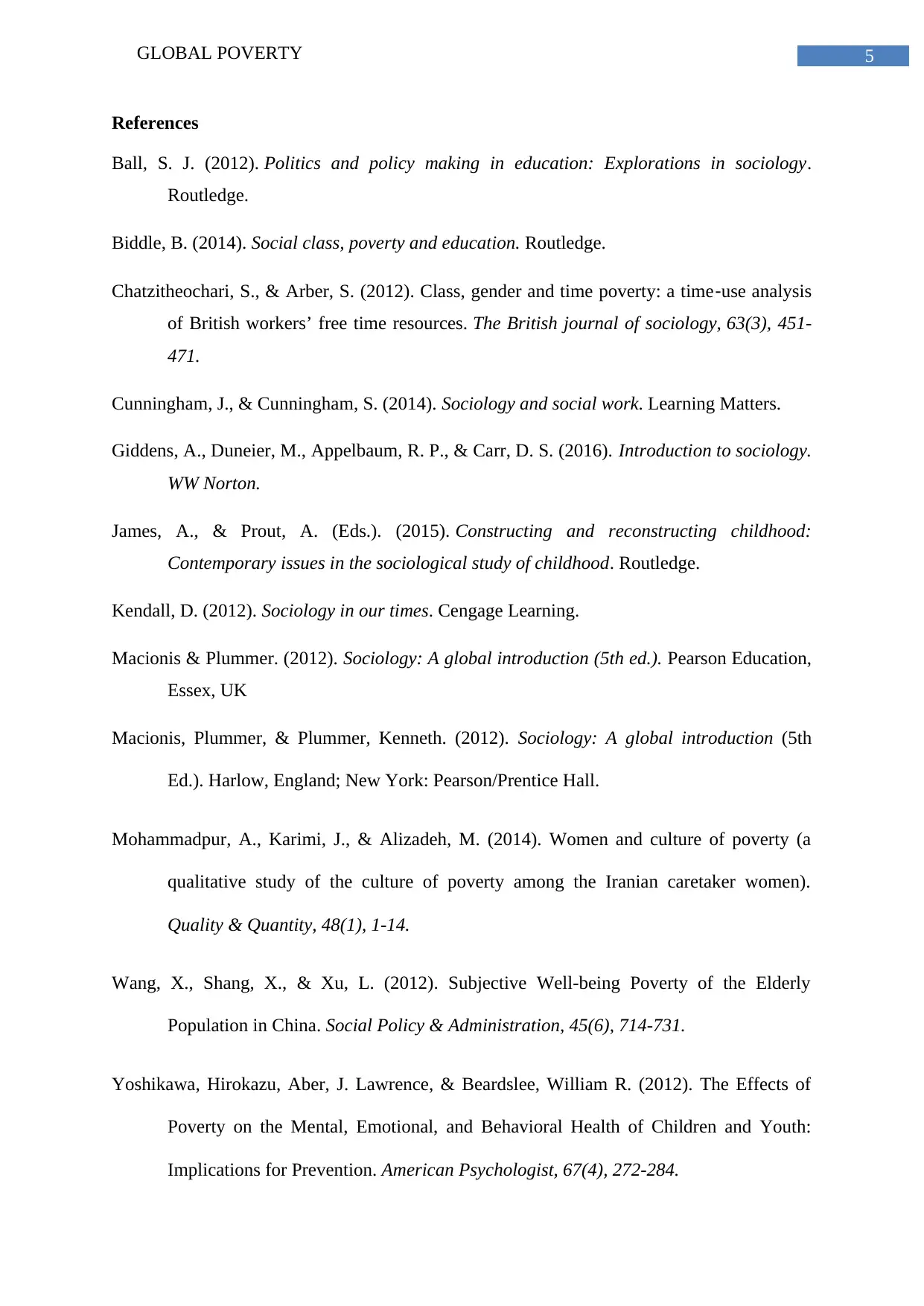
5GLOBAL POVERTY
References
Ball, S. J. (2012). Politics and policy making in education: Explorations in sociology.
Routledge.
Biddle, B. (2014). Social class, poverty and education. Routledge.
Chatzitheochari, S., & Arber, S. (2012). Class, gender and time poverty: a time‐use analysis
of British workers’ free time resources. The British journal of sociology, 63(3), 451-
471.
Cunningham, J., & Cunningham, S. (2014). Sociology and social work. Learning Matters.
Giddens, A., Duneier, M., Appelbaum, R. P., & Carr, D. S. (2016). Introduction to sociology.
WW Norton.
James, A., & Prout, A. (Eds.). (2015). Constructing and reconstructing childhood:
Contemporary issues in the sociological study of childhood. Routledge.
Kendall, D. (2012). Sociology in our times. Cengage Learning.
Macionis & Plummer. (2012). Sociology: A global introduction (5th ed.). Pearson Education,
Essex, UK
Macionis, Plummer, & Plummer, Kenneth. (2012). Sociology: A global introduction (5th
Ed.). Harlow, England; New York: Pearson/Prentice Hall.
Mohammadpur, A., Karimi, J., & Alizadeh, M. (2014). Women and culture of poverty (a
qualitative study of the culture of poverty among the Iranian caretaker women).
Quality & Quantity, 48(1), 1-14.
Wang, X., Shang, X., & Xu, L. (2012). Subjective Well‐being Poverty of the Elderly
Population in China. Social Policy & Administration, 45(6), 714-731.
Yoshikawa, Hirokazu, Aber, J. Lawrence, & Beardslee, William R. (2012). The Effects of
Poverty on the Mental, Emotional, and Behavioral Health of Children and Youth:
Implications for Prevention. American Psychologist, 67(4), 272-284.
References
Ball, S. J. (2012). Politics and policy making in education: Explorations in sociology.
Routledge.
Biddle, B. (2014). Social class, poverty and education. Routledge.
Chatzitheochari, S., & Arber, S. (2012). Class, gender and time poverty: a time‐use analysis
of British workers’ free time resources. The British journal of sociology, 63(3), 451-
471.
Cunningham, J., & Cunningham, S. (2014). Sociology and social work. Learning Matters.
Giddens, A., Duneier, M., Appelbaum, R. P., & Carr, D. S. (2016). Introduction to sociology.
WW Norton.
James, A., & Prout, A. (Eds.). (2015). Constructing and reconstructing childhood:
Contemporary issues in the sociological study of childhood. Routledge.
Kendall, D. (2012). Sociology in our times. Cengage Learning.
Macionis & Plummer. (2012). Sociology: A global introduction (5th ed.). Pearson Education,
Essex, UK
Macionis, Plummer, & Plummer, Kenneth. (2012). Sociology: A global introduction (5th
Ed.). Harlow, England; New York: Pearson/Prentice Hall.
Mohammadpur, A., Karimi, J., & Alizadeh, M. (2014). Women and culture of poverty (a
qualitative study of the culture of poverty among the Iranian caretaker women).
Quality & Quantity, 48(1), 1-14.
Wang, X., Shang, X., & Xu, L. (2012). Subjective Well‐being Poverty of the Elderly
Population in China. Social Policy & Administration, 45(6), 714-731.
Yoshikawa, Hirokazu, Aber, J. Lawrence, & Beardslee, William R. (2012). The Effects of
Poverty on the Mental, Emotional, and Behavioral Health of Children and Youth:
Implications for Prevention. American Psychologist, 67(4), 272-284.
⊘ This is a preview!⊘
Do you want full access?
Subscribe today to unlock all pages.

Trusted by 1+ million students worldwide
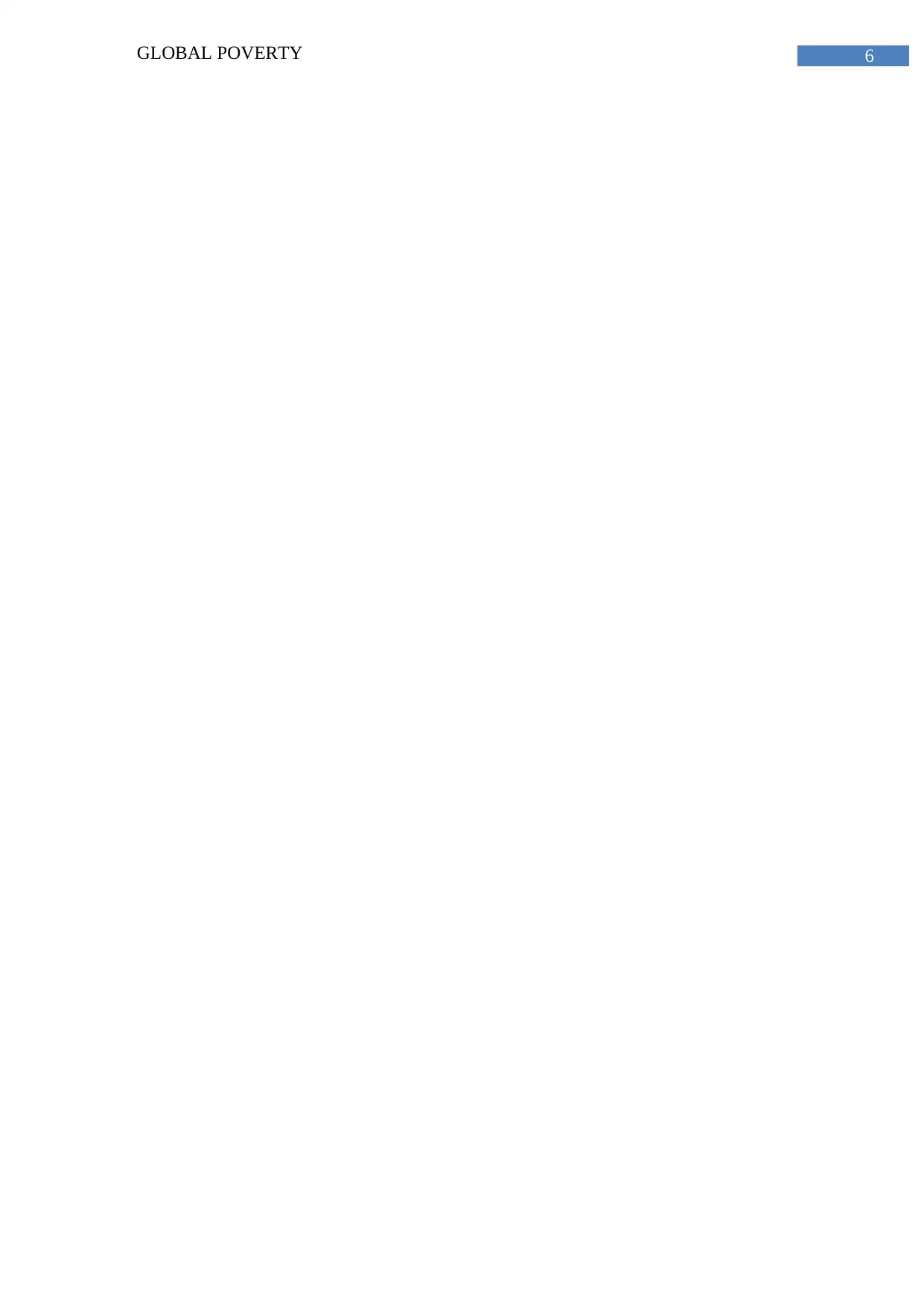
6GLOBAL POVERTY
1 out of 7
Related Documents
Your All-in-One AI-Powered Toolkit for Academic Success.
+13062052269
info@desklib.com
Available 24*7 on WhatsApp / Email
![[object Object]](/_next/static/media/star-bottom.7253800d.svg)
Unlock your academic potential
Copyright © 2020–2025 A2Z Services. All Rights Reserved. Developed and managed by ZUCOL.





